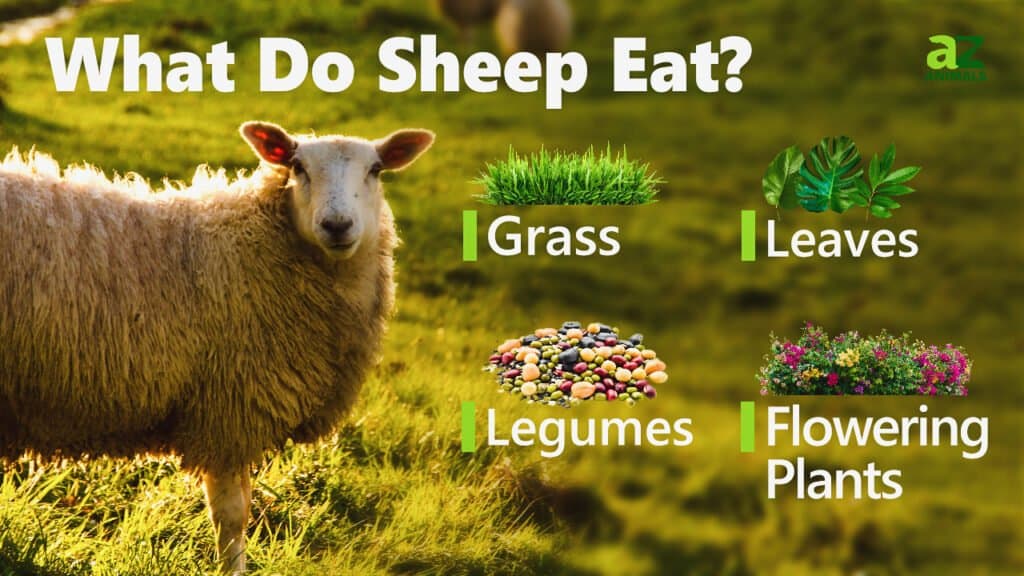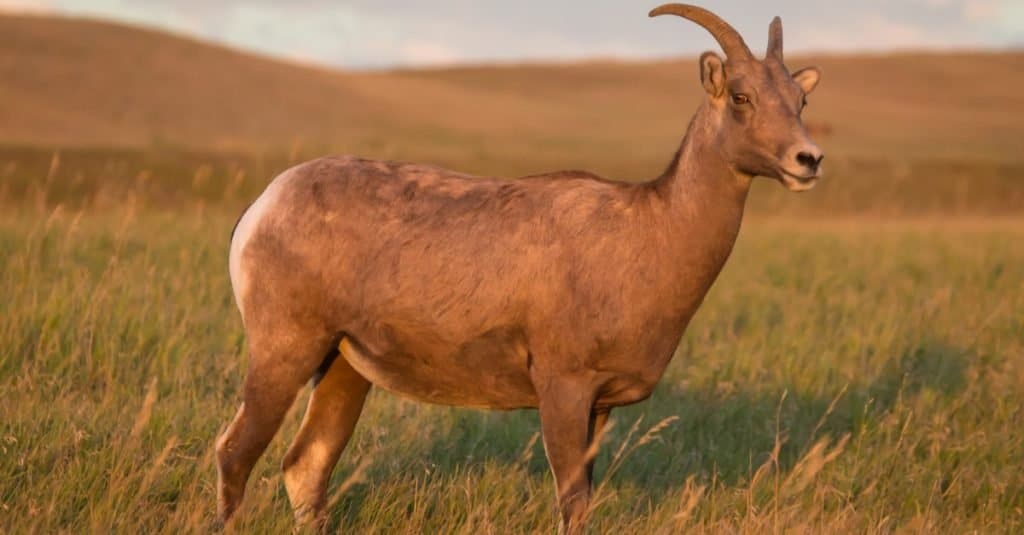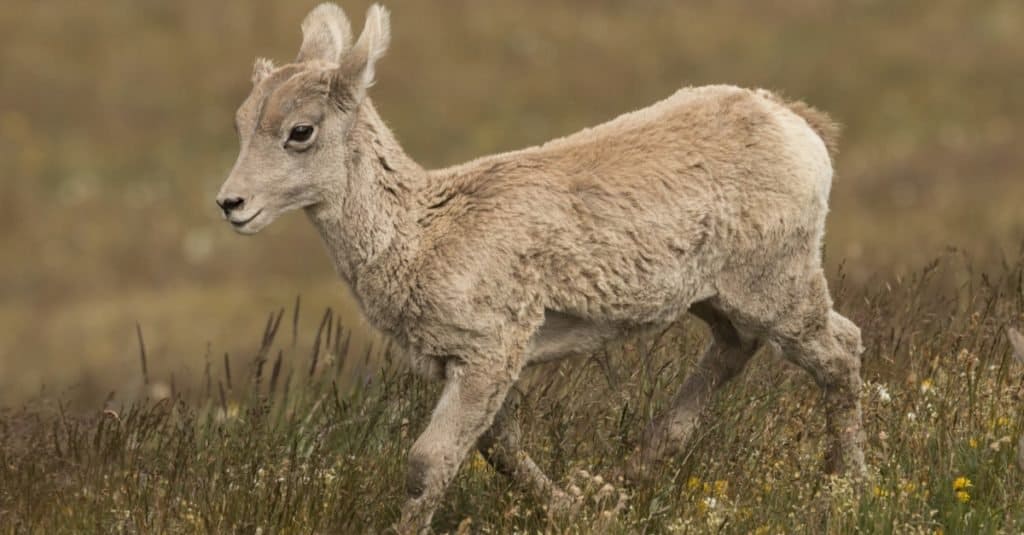Sheep are gentle mammals known for their abundance of fluffy wool and sociable nature. These domesticated animals follow a social hierarchy within their flocks as they graze around farmlands, going where their leader goes. Although they mostly live on farmlands kept by herders, their diet is surprisingly varied. So, what do sheep eat?
Let’s look at the diet of this prized livestock and see what foods they eat and how they survive in captivity and the wild.

What Foods Do Sheep Eat?
Sheep eat grasses, plants, legumes, and forbs, since they are strict herbivores. Interestingly, sheep can survive solely on pasture grass, especially ryegrass and timothy, making them self-sufficient livestock throughout the warmer months.
Sheep are ruminants, like cows, so their digestive system is complex enough to break down the foods they eat. They receive nutrients from plants by chewing their food, regurgitating it as cud, breaking it down further, and then sending it back into their digestive system. Although this may seem unusual, this process allows them to gain nutrition from plants that would have little nutritional value otherwise.
Summary of 15 Foods in Sheep’s Diet
| Rank | Food |
|---|---|
| 1 | Ryegrass |
| 2 | Fescue |
| 3 | Timothy grass |
| 4 | Bromegrass |
| 5 | Reed Canary grass |
| 6 | Kikuyu grass |
| 7 | White clover |
| 8 | Red clover |
| 9 | Alfalfa |
| 10 | Ladino clover |
| 11 | Kura clover |
| 12 | Sunflower seeds |
| 13 | Oats |
| 14 | Dandelions |
| 15 | Hay |
Sheep will eat a wide variety of different foods, but they prefer to eat ones that they can consume quickly. Sheep are a little discerning with some of their foods, though. They will actively avoid woody plants in favor of softer ones that do not require as much chewing or difficulty digesting.
How Much Do Sheep Eat?

On farms and in the wild, sheep graze for many hours each day.
©Warren Metcalf/Shutterstock.com
The feeding requirements of sheep are somewhat high as with most ruminants. Their multi-chambered stomachs require a lot of food to process to make energy for the sheep. Moreover, sheep spend between 6 and 8 hours grazing each day, so they need the energy to find food.
Generally speaking, livestock owners follow a simple formula when determining how much sheep eat. They need to eat about 0.03 pounds of food for every pound they weigh. Adult sheep vary in size from about 100 pounds to 350 pounds. That means very big sheep, usually rams, can eat between 9 pounds and 10 pounds each day.
The benefit of this situation is that the foods sheep consume the most are widely available in pastures, so the sheep will often find their own food and eat at their own pace over their grazing period. However, a large flock of sheep can eat through a pasture’s resources over time, leading farmers to rotate their livestock between fields to prevent them from leaving the area barren.
What Do Sheep Eat in Winter?
The vast majority of sheep are domesticated and live on farms these days. In fact, there are more sheep in Scotland than people, with millions of them living on farms. Although wild sheep still roam around the world, especially in Central Europe and North America, they are not nearly as numerous as captive sheep.
In captivity, sheep tend to feed on whatever they can graze in their pasture along with supplementary foods offered by the farmers. However, sheep have different needs in the winter when most of their pastures lack the growth to support the herd. During that time, it’s up to the farmers to provide for their flocks by offering rich foods along with their typical fare.
In wintertime, sheep will eat:
- Hay
- Grains
- Squash
- Pumpkins
- Sheep feed (requires a special formula with the right amount of copper)
- Silage
Farmers must provide this food to sheep through feeders to reduce the chances of it becoming muddied and inedible. These foods will keep sheep content and healthy while they hunker down through the cold, wet, and windy months.
What Do Lambs Eat?

Young sheep require a mixed diet of milk and grasses
©Michelle Holihan/Shutterstock.com
Baby sheep are known as lambs, and their dietary needs are quite a bit different than those of their parents. Like many other mammals, lambs require milk from their mother for the first portion of their lives. Typically, a lamb will feed on milk exclusively for the first week or two. After that, lambs will begin to eat small amounts of grass and grains.
By the time a lamb is 4 to 6 weeks old, it will be getting about half of its nutrition from the mother’s milk and the other half from grazing or other sources. They will be fully weaned by the time they are 12 to 14 weeks old in farm settings.
From that point on, lambs will follow the ewe herd and graze alongside them for nutrition.
What Predators Eat Sheep?
Sheep are rather docile creatures without a lot of defensive tools at their disposal. Rams, both domestic and wild, can use their powerful headbutts to stymie or kill some other animals. However, they are relatively helpless, preferring to run from a fight.
Take a look at some of the natural predators that sheep face around the world:
As with most animals, the younger, smaller, and older sheep are the ones in the greatest danger from predators. Also, sheep that wander from the flock are targeted more often.
Of course, sheep living on farms have better protection from predators in the form of human structures, herders, guard animals, and mixing the flock with larger creatures to stave off predators. In these cases, though, humans are the primary predator, eventually slaughtering sheep after their wool or milk production runs low.
Sheep are gentle mammals that are mostly kept on farms around the world. Millions of sheep are raised each year for their meat, milk, and wool. While they’re on farms, they feed on many sorts of grasses, legumes, and other plants.
Unfortunately, their disposition puts them in harm’s way since they are rarely aggressive and lack the means to fend off attacks from serious predators. They do have humans watching out for them on farms, keeping them safe with the help of other animals from dogs to llamas.
The photo featured at the top of this post is © N-sky/Shutterstock.com
Thank you for reading! Have some feedback for us? Contact the AZ Animals editorial team.






